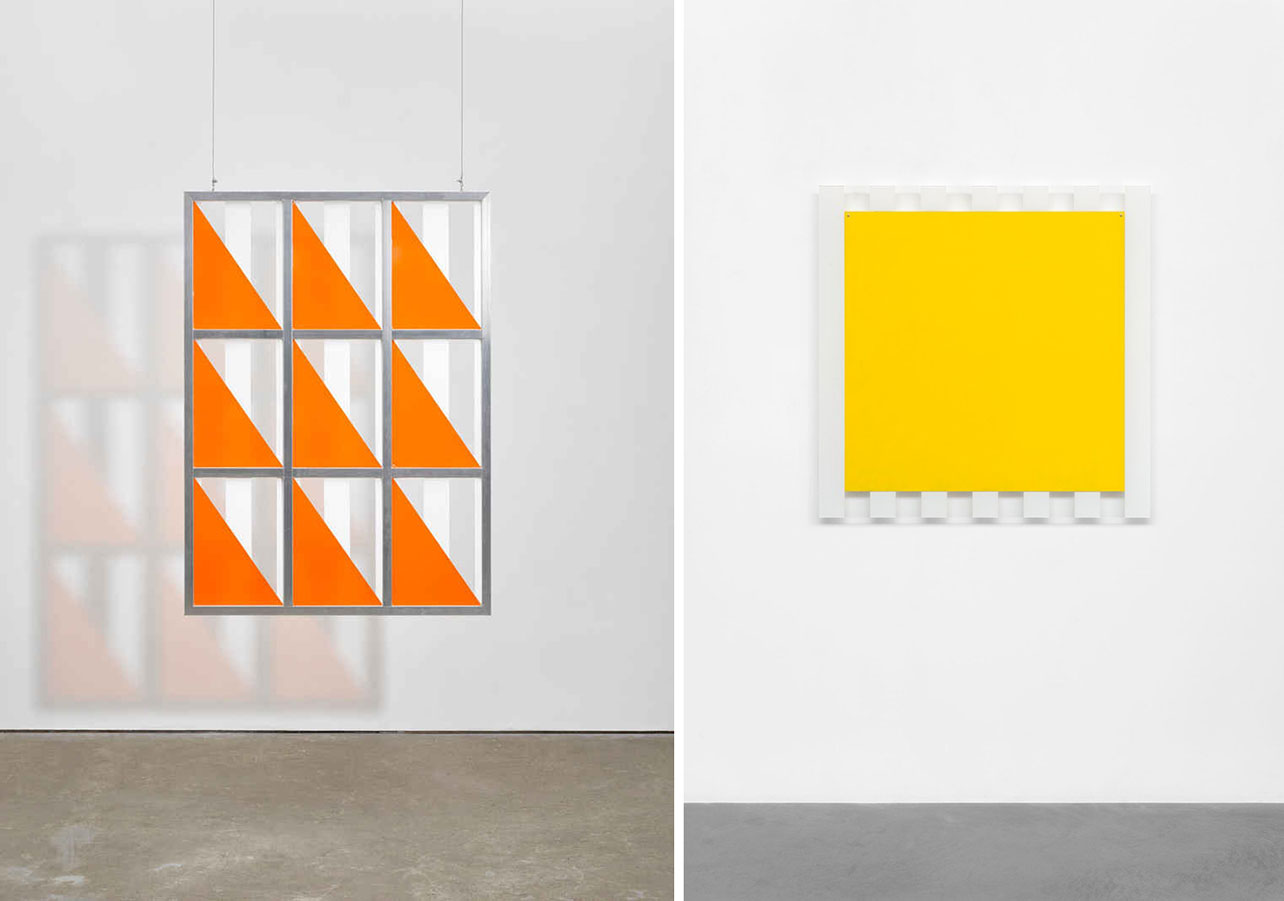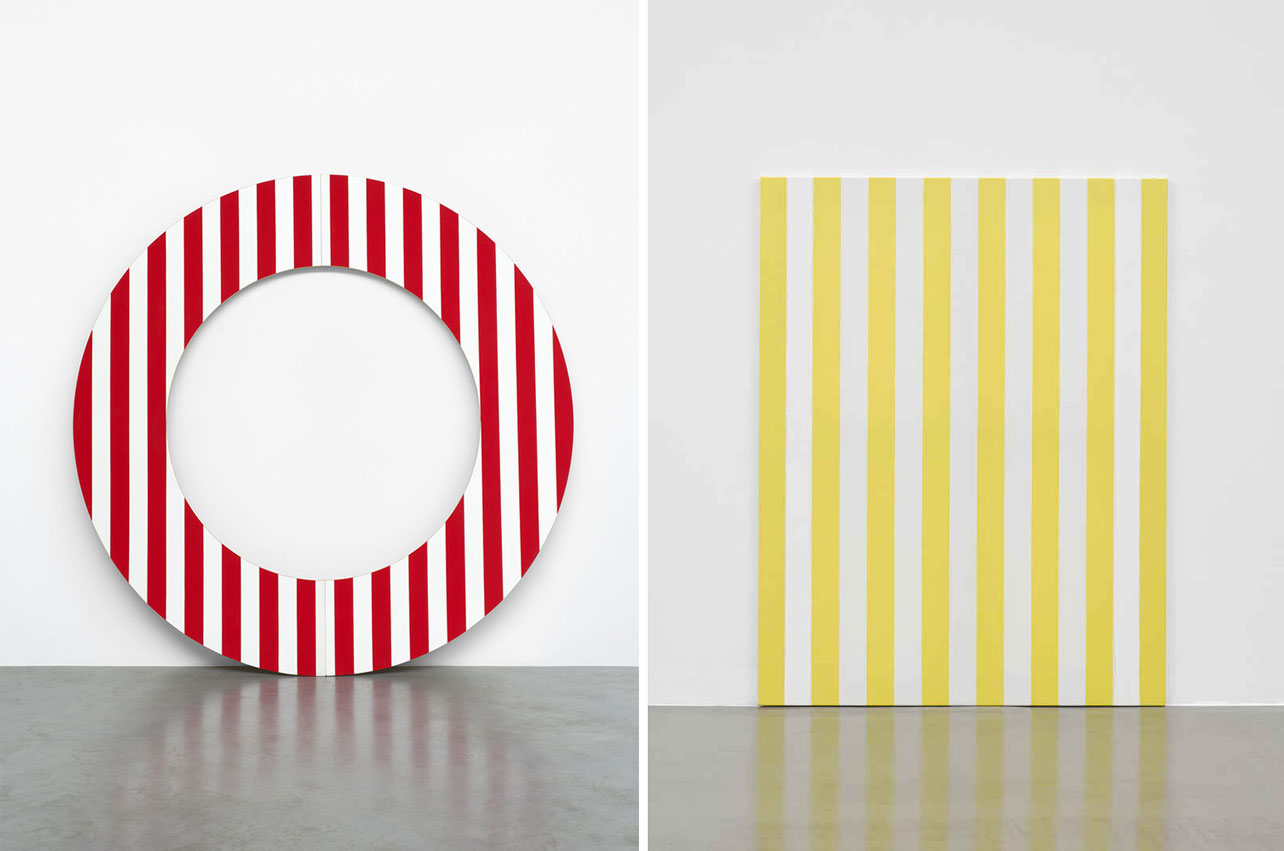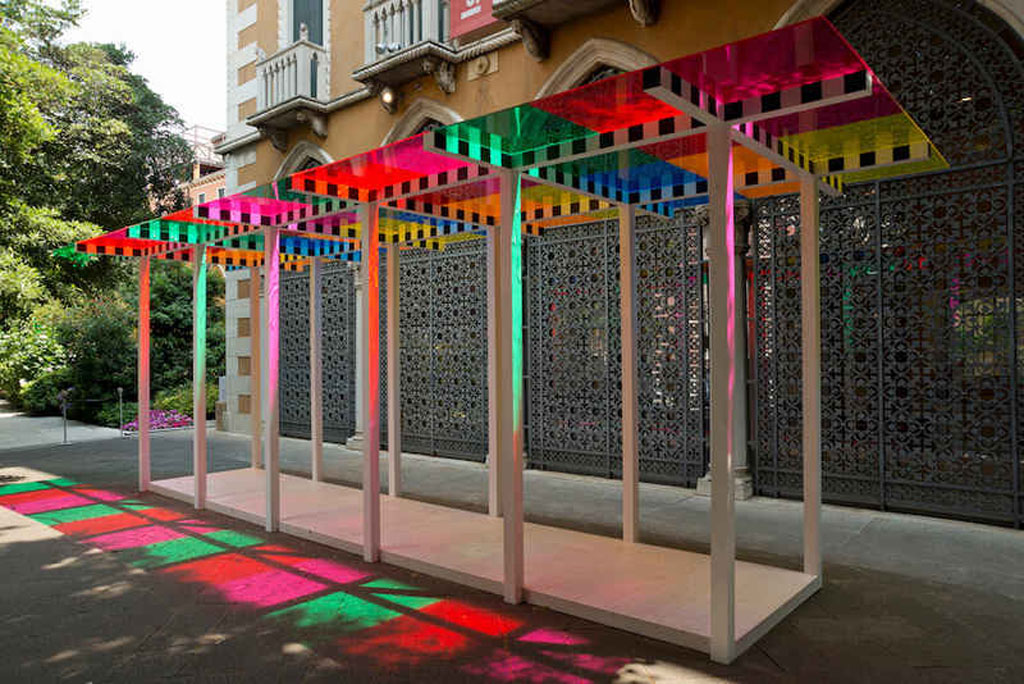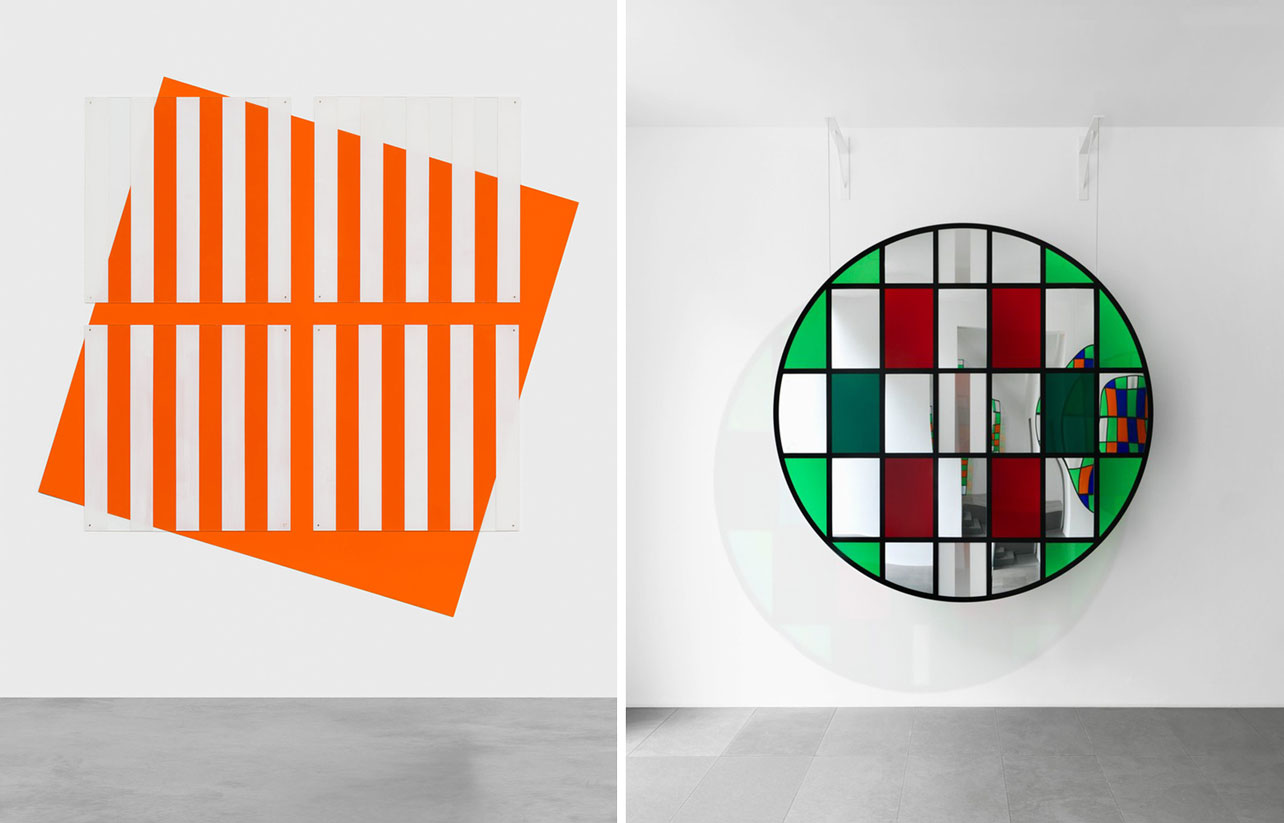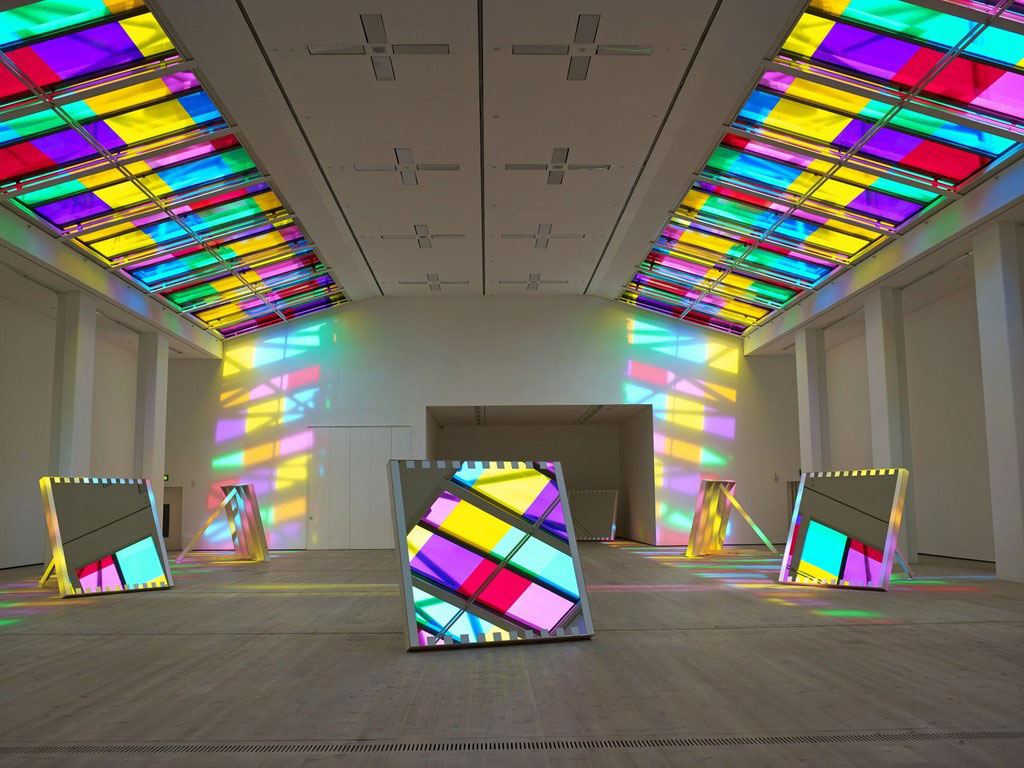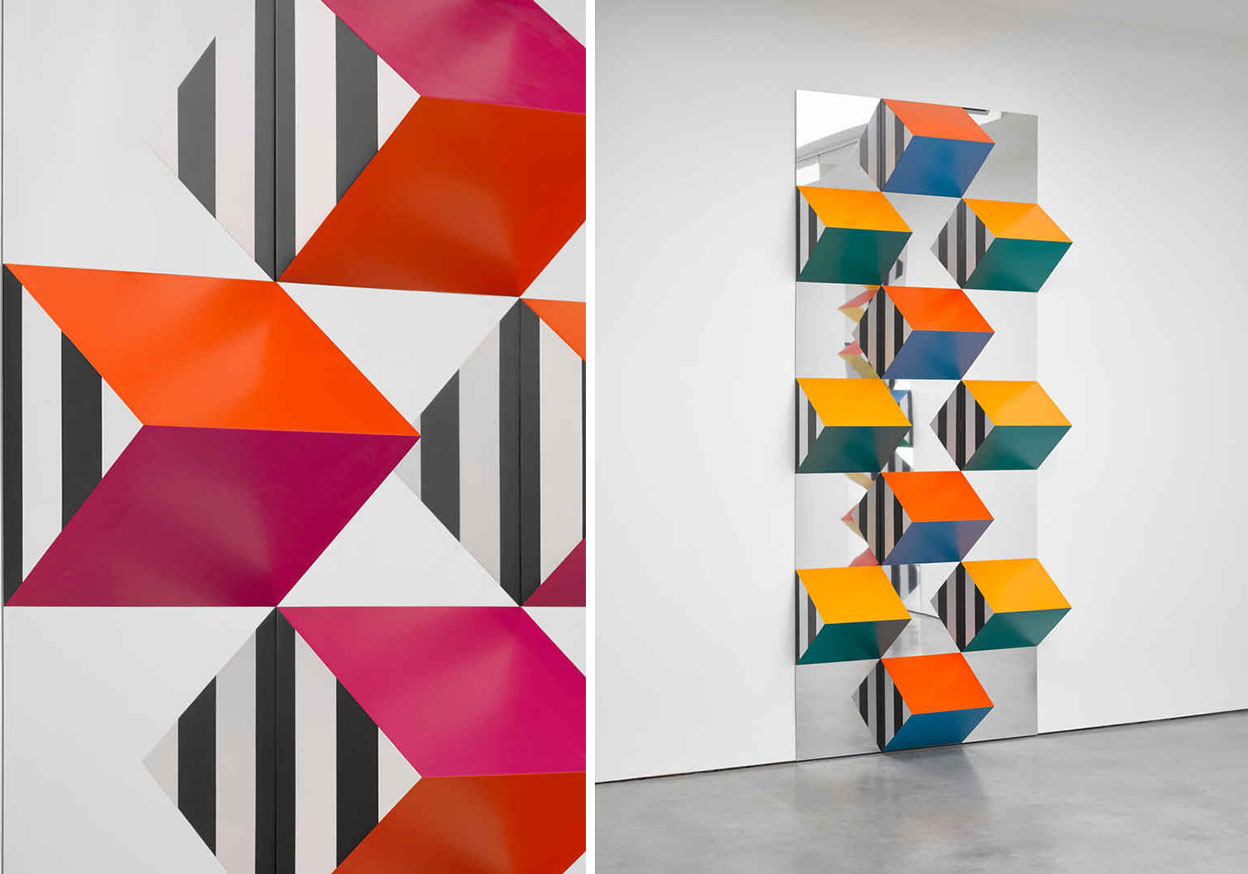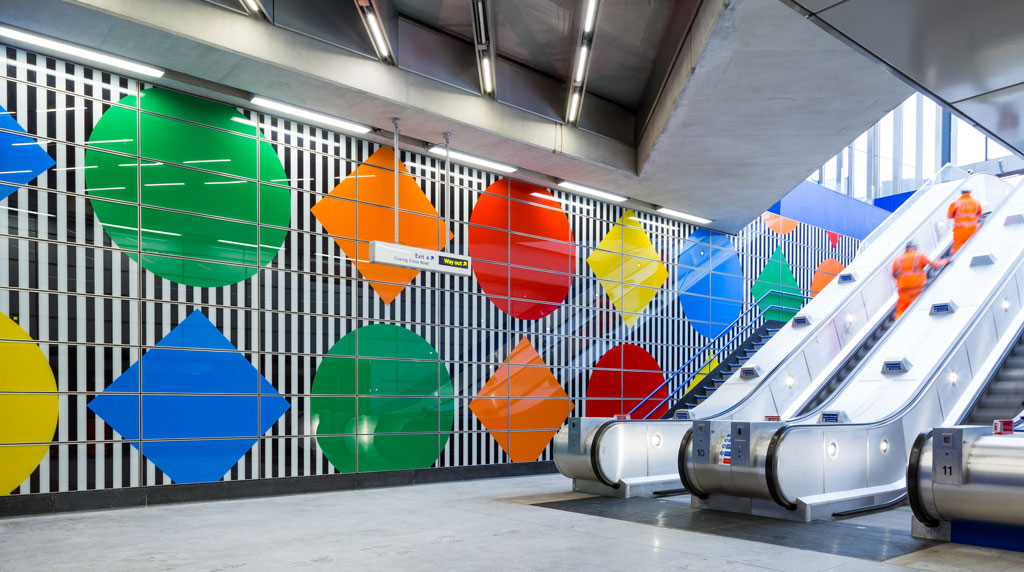TRACES: Daniel Buren
 Today is the occasion to bear in mind Daniel Buren (25/3/1938- ), who has been developing a radical oeuvre characterised by the use of his “visual tool” (8.7 cm-wide alternating white and colored vertical stripes), since the 1960s. He moved from working with paint (1965-67) to working with space and its context. All his works are now conceived specifically for the space, context and features of the host venue and are created in situ, be that in a public space or in a museum or art gallery. This column is a tribute to artists, living or dead, who have left their mark in Contemporary Art. Through documents or interviews, starting with: moments and memories, we reveal out from the past-unknown sides of big personalities, who left their indelible traces in time and history…
Today is the occasion to bear in mind Daniel Buren (25/3/1938- ), who has been developing a radical oeuvre characterised by the use of his “visual tool” (8.7 cm-wide alternating white and colored vertical stripes), since the 1960s. He moved from working with paint (1965-67) to working with space and its context. All his works are now conceived specifically for the space, context and features of the host venue and are created in situ, be that in a public space or in a museum or art gallery. This column is a tribute to artists, living or dead, who have left their mark in Contemporary Art. Through documents or interviews, starting with: moments and memories, we reveal out from the past-unknown sides of big personalities, who left their indelible traces in time and history…
By Efi Michalarou
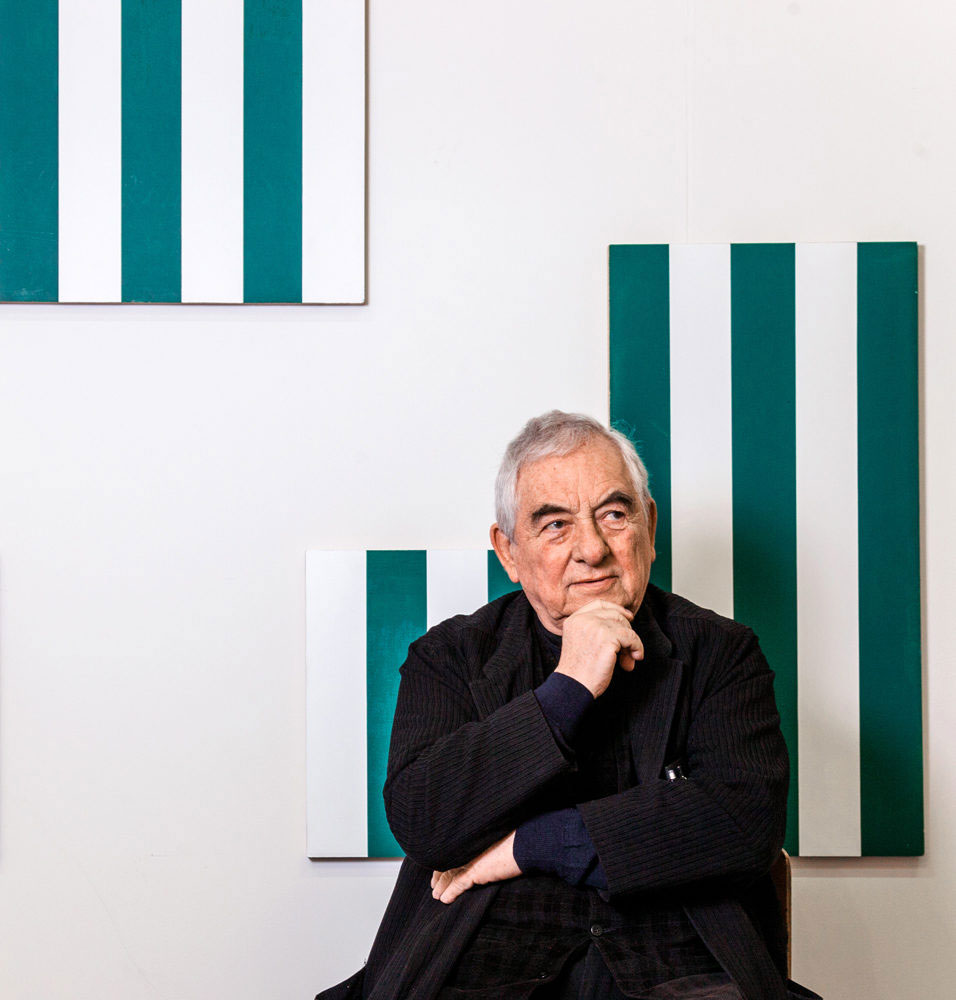 Daniel Buren was born in Boulogne-Billancourt (Paris), France in 25/3/1938. He graduated from the Ecole Nationale Supérieure des Métiers d’Art in Paris, in 1960 and began painting in the early 1960s. However, by 1965 – a year he spent in the Grapetree Bay Hotel on the Caribbean island of Saint Croix where he was contracted to make frescoes, he had abandoned traditional painting for the 8.7 cm-wide vertical stripes, which alternated between white and one color, which have become his signature. Buren received considerable early success in Paris, winning both the Grand Prix at the Paris Biennale and the Prix Lefranc de la Jeune Peinture (prize for young painters) in 1965. Soon after this, he started working with Olivier Mosset, Michel Parmentier and Niele Toroni. Together, the four painters formed the group BMPT, whose aim was to disrupt and challenge traditional notions of authorship and exhibition. They also sought to produce paintings that were without extrinsic meaning or art historical references, focusing on the works’ objecthood as paintings and attempting to eradicate the mystique and aura of art. Although he had already adopted his signature stripes when he started working with the group, BMPT’s theories and approaches helped to develop and strengthen the logic behind his choice. He later explained that he selected this signature technique because “stripes are boring… the reason I use the stripes is because it is absolutely meaningless”. BMPT wanted to challenge the concepts of artistic talent and originality, as well as the genius of the individual artist. They did this by signing each other’s work and by staging unexpected “happenings” in one, the paying audience was forced to sit for an hour looking at four paintings which had ostensibly been hung as a backdrop to a conference that then never took place. Marcel Duchamp is said to have been impressed by how frustrating the experience was for the audience. Buren’s first major solo show was held at Galleria Apollinaire in Milan in 1968, during which he blocked the entrance to the gallery with his stripes. In May 1968, he also took part in the influential student demonstrations in Paris, sharing the protestors’ anti-establishment feelings. In 1969, Harald Szeemann curated the groundbreaking exhibition “When Attitudes Become Form” in Bern, Switzerland, in which process-focused and Conceptual artists were given the freedom to present avant-garde and experimental work in an institutional setting. All of Buren’s artist friends were involved and although Szeemann had visited his studio while researching for the exhibition, he was not invited. Given that the premise of the exhibition was artistic freedom, Buren felt that he should be able to contribute despite this and so arrived in Bern three days before the show’s opening to see how he might intervene. On arrival in the Bern Kunsthalle, Joseph Beuys asked Buren where his work was, and on discovering he had not been invited, offered Buren a section of Beuys’ own large exhibition space to show his striped papers. On consideration Buren thanked Beuys, but instead made a statement outside the walls of the institution and covered billboards around the city in his signature stripes the night before the exhibition opening. His antics caused him to be arrested and he had to flee Switzerland to escape the authorities. This was part of a series of guerrilla-style artistic interventions in public spaces made by Buren, who in the earlier stages of his career rarely had permission from the relevant authorities. In the late 1960s, for example, he embarked on a campaign of fly-posting posters of his black-and-white stripes around Paris and in 1970 he illegally painted his stripes on benches around Los Angeles. In 1971, Buren was invited to take part in a group show at the Guggenheim, which was intended to allow artists to explore unconventional aspects of the building. Buren created a large banner, which was hung in the central space of the museum. However, Donald Judd and Dan Flavin complained that the work obscured their own pieces, and the piece was removed the day before the exhibition’s opening. In the 1970s, Buren engaged in a number of solo and collaborative performance pieces. These included a boat race in which all the yachts had sails were decorated with Buren’s stripes, and a performance in Berlin alongside Jannis Kounellis, Wolf Vostell and other artists as part of “ADA – Aktionen der Avantgarde”. By the 1980s, Buren was more focused on creating large-scale installations in public spaces. The most famous of these was his 1986 work “Les Deux Plateaux” in the courtyard of the Palais Royal in Paris. In the same year, Buren exhibited a solo pavilion for France at the Venice Biennale, and was awarded the prestigious Golden Lion award for his installation. In recent years, Buren’s work has become more interested in the architectural and in creating spaces that are both architectural in their own right and respond to the surrounding buildings. His later period has also been characterized by a series of permanent installations, including at Guggenheim Museum in Bilbao and the Musée Fabre in Montpellier. In 2007, Buren contributed work once more to the Venice Biennale and also curated a selection of work by the younger installation, performance, and conceptual artist, Sophie Calle, for the French pavilion. Buren continues to make art, often working in public spaces. For example in 2017, Buren created a permanent site-specific installation in Tottenham Court Road London Underground station. For his site-specific work “L’Observatoire de la lumière” at the Fondation Louis Vuitton in 2016, the 12 “sails” formed of 3,600 pieces of glass, were covered by an array of 13 chromatic filters that are in turn punctuated, at equal distances from one another, by alternating white and black stripes perpendicular to the ground.
Daniel Buren was born in Boulogne-Billancourt (Paris), France in 25/3/1938. He graduated from the Ecole Nationale Supérieure des Métiers d’Art in Paris, in 1960 and began painting in the early 1960s. However, by 1965 – a year he spent in the Grapetree Bay Hotel on the Caribbean island of Saint Croix where he was contracted to make frescoes, he had abandoned traditional painting for the 8.7 cm-wide vertical stripes, which alternated between white and one color, which have become his signature. Buren received considerable early success in Paris, winning both the Grand Prix at the Paris Biennale and the Prix Lefranc de la Jeune Peinture (prize for young painters) in 1965. Soon after this, he started working with Olivier Mosset, Michel Parmentier and Niele Toroni. Together, the four painters formed the group BMPT, whose aim was to disrupt and challenge traditional notions of authorship and exhibition. They also sought to produce paintings that were without extrinsic meaning or art historical references, focusing on the works’ objecthood as paintings and attempting to eradicate the mystique and aura of art. Although he had already adopted his signature stripes when he started working with the group, BMPT’s theories and approaches helped to develop and strengthen the logic behind his choice. He later explained that he selected this signature technique because “stripes are boring… the reason I use the stripes is because it is absolutely meaningless”. BMPT wanted to challenge the concepts of artistic talent and originality, as well as the genius of the individual artist. They did this by signing each other’s work and by staging unexpected “happenings” in one, the paying audience was forced to sit for an hour looking at four paintings which had ostensibly been hung as a backdrop to a conference that then never took place. Marcel Duchamp is said to have been impressed by how frustrating the experience was for the audience. Buren’s first major solo show was held at Galleria Apollinaire in Milan in 1968, during which he blocked the entrance to the gallery with his stripes. In May 1968, he also took part in the influential student demonstrations in Paris, sharing the protestors’ anti-establishment feelings. In 1969, Harald Szeemann curated the groundbreaking exhibition “When Attitudes Become Form” in Bern, Switzerland, in which process-focused and Conceptual artists were given the freedom to present avant-garde and experimental work in an institutional setting. All of Buren’s artist friends were involved and although Szeemann had visited his studio while researching for the exhibition, he was not invited. Given that the premise of the exhibition was artistic freedom, Buren felt that he should be able to contribute despite this and so arrived in Bern three days before the show’s opening to see how he might intervene. On arrival in the Bern Kunsthalle, Joseph Beuys asked Buren where his work was, and on discovering he had not been invited, offered Buren a section of Beuys’ own large exhibition space to show his striped papers. On consideration Buren thanked Beuys, but instead made a statement outside the walls of the institution and covered billboards around the city in his signature stripes the night before the exhibition opening. His antics caused him to be arrested and he had to flee Switzerland to escape the authorities. This was part of a series of guerrilla-style artistic interventions in public spaces made by Buren, who in the earlier stages of his career rarely had permission from the relevant authorities. In the late 1960s, for example, he embarked on a campaign of fly-posting posters of his black-and-white stripes around Paris and in 1970 he illegally painted his stripes on benches around Los Angeles. In 1971, Buren was invited to take part in a group show at the Guggenheim, which was intended to allow artists to explore unconventional aspects of the building. Buren created a large banner, which was hung in the central space of the museum. However, Donald Judd and Dan Flavin complained that the work obscured their own pieces, and the piece was removed the day before the exhibition’s opening. In the 1970s, Buren engaged in a number of solo and collaborative performance pieces. These included a boat race in which all the yachts had sails were decorated with Buren’s stripes, and a performance in Berlin alongside Jannis Kounellis, Wolf Vostell and other artists as part of “ADA – Aktionen der Avantgarde”. By the 1980s, Buren was more focused on creating large-scale installations in public spaces. The most famous of these was his 1986 work “Les Deux Plateaux” in the courtyard of the Palais Royal in Paris. In the same year, Buren exhibited a solo pavilion for France at the Venice Biennale, and was awarded the prestigious Golden Lion award for his installation. In recent years, Buren’s work has become more interested in the architectural and in creating spaces that are both architectural in their own right and respond to the surrounding buildings. His later period has also been characterized by a series of permanent installations, including at Guggenheim Museum in Bilbao and the Musée Fabre in Montpellier. In 2007, Buren contributed work once more to the Venice Biennale and also curated a selection of work by the younger installation, performance, and conceptual artist, Sophie Calle, for the French pavilion. Buren continues to make art, often working in public spaces. For example in 2017, Buren created a permanent site-specific installation in Tottenham Court Road London Underground station. For his site-specific work “L’Observatoire de la lumière” at the Fondation Louis Vuitton in 2016, the 12 “sails” formed of 3,600 pieces of glass, were covered by an array of 13 chromatic filters that are in turn punctuated, at equal distances from one another, by alternating white and black stripes perpendicular to the ground. 
